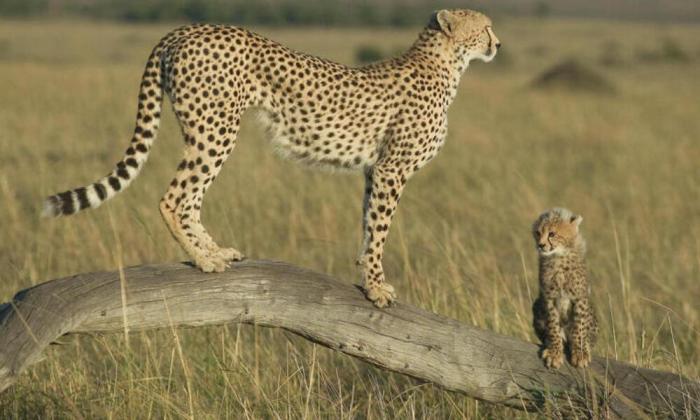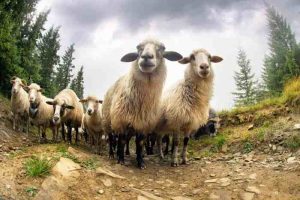
Step into the world where wild animals and climate change collide, shaping a narrative of resilience, adaptation, and struggle for survival.
From the altering habitats to the shifting behaviors, get ready to explore how the animal kingdom navigates through the challenges of a warming planet.
Introduction to Wild Animals and Climate Change

Climate change has a significant impact on the habitats of wild animals around the world. As temperatures rise and weather patterns become more unpredictable, the natural environments that many species rely on for survival are being altered at an alarming rate. This disruption poses numerous challenges for wildlife, including changes in behavior and migration patterns, as well as threats to their overall survival.
Impact on Wild Animal Habitats
Climate change is leading to the loss and degradation of habitats critical for the survival of many wild animal species. Rising temperatures, deforestation, and changes in precipitation patterns are causing ecosystems to shift, fragment, or disappear entirely. This loss of habitat can result in a significant decline in biodiversity and can push many species to the brink of extinction.
- Loss of polar ice caps threatens the habitat of polar bears, seals, and other Arctic species.
- Deforestation in the Amazon rainforest endangers the habitat of jaguars, sloths, and countless other species.
Behavior and Migration Patterns
Climate change can disrupt the behavior and migration patterns of wild animals in various ways. Shifts in temperature and weather patterns can alter the availability of food sources, breeding grounds, and shelter, forcing animals to adapt or relocate in search of suitable conditions.
- Polar bears are being forced to travel greater distances in search of sea ice for hunting, leading to increased energy expenditure and decreased reproductive success.
- Migratory birds are facing challenges as changing temperatures affect the timing of their migrations, impacting their ability to find food and suitable breeding areas.
Threatened Wild Animal Species
Numerous wild animal species are currently threatened by the impacts of climate change on their habitats and survival. From iconic predators to lesser-known insects, many creatures are struggling to cope with the rapid changes brought about by a warming planet.
- The iconic African elephant is facing habitat loss and increased human-wildlife conflict due to changing weather patterns and deforestation.
- The Adelie penguin population is declining rapidly as warming temperatures reduce their access to food sources and nesting sites.
Effects of Climate Change on Animals
Climate change is having a profound impact on wild animals around the world, disrupting their natural habitats and threatening their survival.
Rising Temperatures Alter Ecosystems
Rising temperatures due to climate change are altering ecosystems where wild animals live, leading to shifts in vegetation patterns and changes in food availability.
- Some species may struggle to adapt to these rapid changes, leading to population declines and increased competition for resources.
- Polar bears, for example, are facing habitat loss as sea ice melts, making it challenging for them to hunt for food.
Challenges in Finding Food and Water
Wild animals are facing challenges in finding food and water due to climate change, as droughts, floods, and other extreme weather events disrupt their access to resources.
- Animals like elephants and rhinos are struggling to find water sources during prolonged droughts, leading to dehydration and increased mortality rates.
- Bird species that rely on specific plants or insects for food may suffer as these resources disappear or shift to new locations.
Impact of Extreme Weather Events
Extreme weather events, such as hurricanes, wildfires, and heatwaves, can have a devastating impact on the survival of various wild animal populations.
- Wildfires can destroy habitats and displace animals, leaving them vulnerable to predators or starvation.
- Heatwaves can cause heat stress and dehydration in animals, leading to mass die-offs in affected populations.
Adaptation Strategies of Wild Animals
Wild animals have developed various adaptive behaviors to cope with changing environmental conditions, including climate change. These strategies allow them to survive and thrive in altered habitats and climates. Let’s explore some of the ways wild animals adapt to these challenges.
Behavioral Adaptations
Wild animals exhibit behavioral changes in response to climate change. For example, some species have shifted their feeding patterns or altered their breeding seasons to align with changing weather patterns. By adjusting their behavior, these animals can better adapt to the new conditions and ensure their survival.
Habitat Adjustment
Another adaptation strategy is habitat adjustment. Wild animals may move to higher altitudes or latitudes to find suitable environmental conditions as temperatures rise. This migration helps them find food, shelter, and breeding grounds that are more conducive to their survival. For instance, polar bears are moving further north as Arctic ice melts, searching for suitable hunting grounds.
Natural Selection
Natural selection plays a crucial role in shaping the ability of wild animals to adapt to a changing climate. Individuals within a species that possess traits better suited to the new environmental conditions are more likely to survive and reproduce, passing on these advantageous traits to future generations. Over time, this process leads to the evolution of populations that are better adapted to the changing climate.
Comparison between Wild Animals and Livestock
When it comes to the impacts of climate change, wild animals and livestock are affected differently due to their distinct habitats and lifestyles.
Different Impacts of Climate Change
- Wild Animals: Wild animals have to deal with habitat loss, changes in food availability, and increased competition for resources due to climate change. This can lead to population decline and even extinction in some species.
- Livestock: Livestock animals are often kept in controlled environments by humans, but climate change can still affect them through heat stress, diseases, and changes in the availability of food and water.
Resilience to Climate Change
- Wild Animals: Wild animal populations have evolved over time to adapt to changing environmental conditions. They may have higher resilience to climate change due to their ability to migrate, change behaviors, or find new habitats.
- Livestock: Livestock animals are more vulnerable to climate change as they rely on humans for food, shelter, and healthcare. They may not have the same level of adaptability as wild animals.
Role of Human Intervention
- Wild Animals: Human intervention plays a crucial role in conserving wild animal populations by establishing protected areas, implementing conservation measures, and reducing human activities that contribute to climate change.
- Livestock: Humans have a direct impact on the well-being of livestock animals. Through sustainable farming practices, proper animal welfare standards, and climate-resilient breeding, humans can help mitigate the effects of climate change on livestock.
Conservation Efforts for Wild Animals
Conservation efforts play a crucial role in protecting wild animal species that are threatened by the impacts of climate change. Preserving biodiversity is essential for the long-term survival of these animals, as they play a key role in maintaining ecosystem balance and stability.
Role of National Parks and Protected Areas
National parks, reserves, and protected areas are vital for safeguarding habitats for wild animals in the face of climate change. These designated areas provide a safe haven for wildlife to thrive without the threat of habitat destruction or human interference.
- These protected areas act as a buffer against the negative effects of climate change, providing a stable environment for wild animals to adapt and survive.
- Conservation initiatives within national parks focus on preserving natural habitats, managing human-wildlife conflicts, and implementing measures to mitigate the impacts of climate change.
- By creating wildlife corridors and protected zones, national parks help connect fragmented habitats, allowing animals to move freely and maintain genetic diversity.
Community Involvement in Conservation
Engaging local communities in conservation efforts is crucial for the success of protecting wild animal species. Collaboration with indigenous groups, local stakeholders, and conservation organizations can lead to sustainable conservation practices.
- Community-based conservation projects promote coexistence between humans and wildlife, reducing conflicts and supporting the long-term survival of endangered species.
- Education and awareness programs raise public consciousness about the importance of wildlife conservation and encourage responsible behavior towards nature and wildlife.
- Ecotourism initiatives in and around protected areas can generate revenue for conservation efforts while providing economic opportunities for local communities.
Epilogue

As we conclude our journey through the realms of wild animals and climate change, remember that the fate of these species rests in our hands. Let’s strive to be stewards of the environment and protect these magnificent creatures for generations to come.
FAQ Guide
How do wild animals respond to climate change?
Wild animals exhibit adaptive behaviors and may adjust their habitats or migration routes to cope with changing environmental conditions.
What role do national parks play in protecting wild animals from climate change?
National parks, reserves, and protected areas serve as crucial habitats for wild animals, safeguarding them in the face of climate change.
Are all wild animal species equally threatened by climate change?
No, the impact of climate change varies among species, with some facing more immediate threats than others based on their habitats and adaptations.






